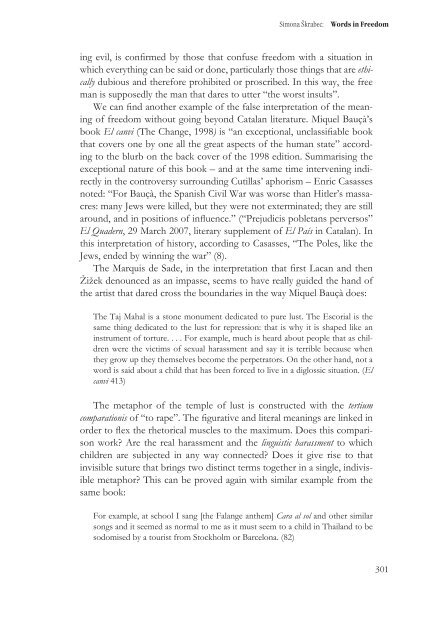Literatura in cenzura - Društvo za primerjalno književnost - ZRC SAZU
Literatura in cenzura - Društvo za primerjalno književnost - ZRC SAZU
Literatura in cenzura - Društvo za primerjalno književnost - ZRC SAZU
- No tags were found...
Create successful ePaper yourself
Turn your PDF publications into a flip-book with our unique Google optimized e-Paper software.
Simona Škrabec:Words <strong>in</strong> Freedom<strong>in</strong>g evil, is confirmed by those that confuse freedom with a situation <strong>in</strong>which everyth<strong>in</strong>g can be said or done, particularly those th<strong>in</strong>gs that are ethicallydubious and therefore prohibited or proscribed. In this way, the freeman is supposedly the man that dares to utter “the worst <strong>in</strong>sults”.We can f<strong>in</strong>d another example of the false <strong>in</strong>terpretation of the mean<strong>in</strong>gof freedom without go<strong>in</strong>g beyond Catalan literature. Miquel Bauçà’sbook El canvi (The Change, 1998) is “an exceptional, unclassifiable bookthat covers one by one all the great aspects of the human state” accord<strong>in</strong>gto the blurb on the back cover of the 1998 edition. Summaris<strong>in</strong>g theexceptional nature of this book – and at the same time <strong>in</strong>terven<strong>in</strong>g <strong>in</strong>directly<strong>in</strong> the controversy surround<strong>in</strong>g Cutillas’ aphorism – Enric Casassesnoted: “For Bauçà, the Spanish Civil War was worse than Hitler’s massacres:many Jews were killed, but they were not exterm<strong>in</strong>ated; they are stillaround, and <strong>in</strong> positions of <strong>in</strong>fluence.” (“Prejudicis pobletans perversos”El Quadern, 29 March 2007, literary supplement of El País <strong>in</strong> Catalan). Inthis <strong>in</strong>terpretation of history, accord<strong>in</strong>g to Casasses, “The Poles, like theJews, ended by w<strong>in</strong>n<strong>in</strong>g the war” (8).The Marquis de Sade, <strong>in</strong> the <strong>in</strong>terpretation that first Lacan and thenŽižek denounced as an impasse, seems to have really guided the hand ofthe artist that dared cross the boundaries <strong>in</strong> the way Miquel Bauçà does:The Taj Mahal is a stone monument dedicated to pure lust. The Escorial is thesame th<strong>in</strong>g dedicated to the lust for repression: that is why it is shaped like an<strong>in</strong>strument of torture. . . . For example, much is heard about people that as childrenwere the victims of sexual harassment and say it is terrible because whenthey grow up they themselves become the perpetrators. On the other hand, not aword is said about a child that has been forced to live <strong>in</strong> a diglossic situation. (Elcanvi 413)The metaphor of the temple of lust is constructed with the tertiumcomparationis of “to rape”. The figurative and literal mean<strong>in</strong>gs are l<strong>in</strong>ked <strong>in</strong>order to flex the rhetorical muscles to the maximum. Does this comparisonwork? Are the real harassment and the l<strong>in</strong>guistic harassment to whichchildren are subjected <strong>in</strong> any way connected? Does it give rise to that<strong>in</strong>visible suture that br<strong>in</strong>gs two dist<strong>in</strong>ct terms together <strong>in</strong> a s<strong>in</strong>gle, <strong>in</strong>divisiblemetaphor? This can be proved aga<strong>in</strong> with similar example from thesame book:For example, at school I sang [the Falange anthem] Cara al sol and other similarsongs and it seemed as normal to me as it must seem to a child <strong>in</strong> Thailand to besodomised by a tourist from Stockholm or Barcelona. (82)301
















